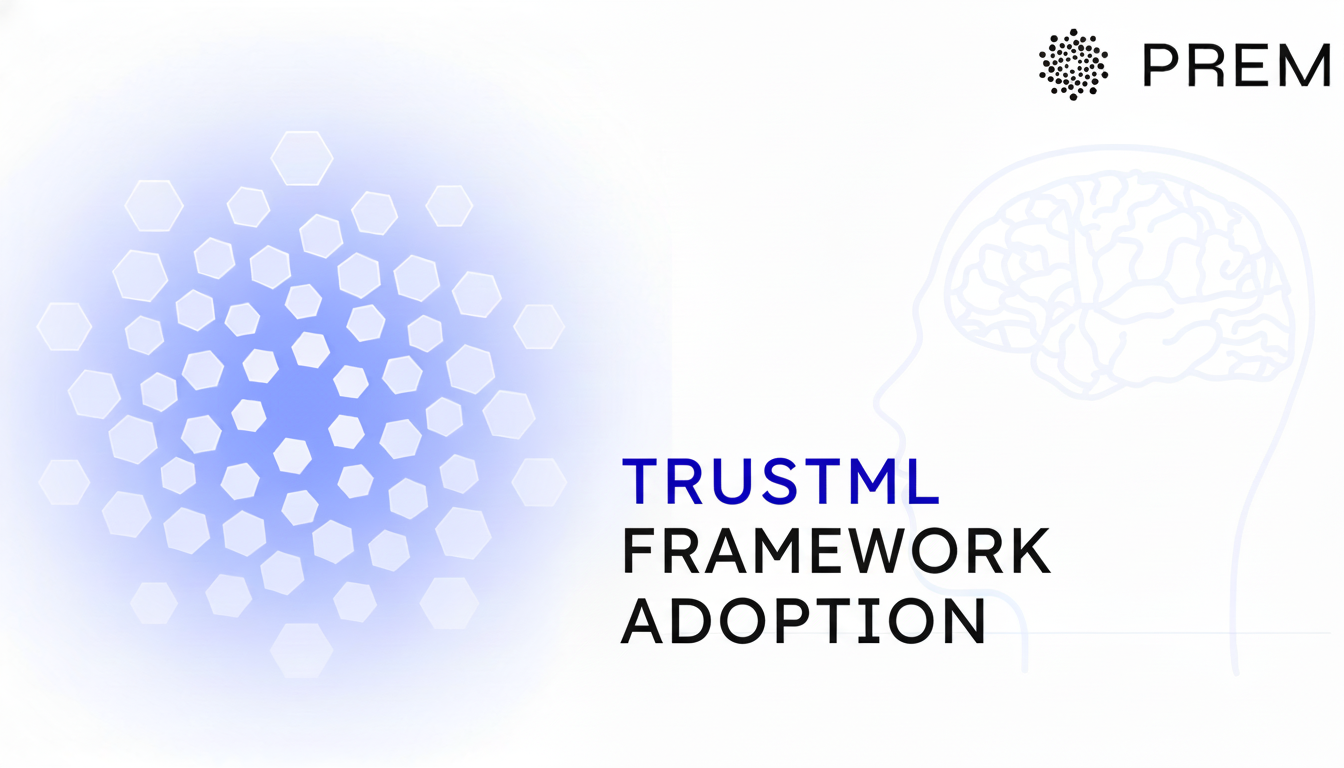10 TrustML Framework Adoption Rates
Explore 10 key stats on TrustML adoption. Learn how enterprises close the AI trust gap, cut costs by 70% with sovereign infrastructure, and achieve sub-100ms encrypted performance through privacy-preserving, compliant AI frameworks.

Key Takeaways
- 46% of organizations experience critical misalignment between perceived AI system trust and actual reliability, creating operational risks that privacy-preserving frameworks address
- While 78% claim trust in AI systems, only 40% implement necessary governance safeguards—exposing significant vulnerability gaps
- Organizations achieve 50-70% cost reduction by deploying privacy-preserving AI on sovereign infrastructure with sub-100ms response times versus 300ms+ cloud latency
- ML cybersecurity startups saw a 52% funding surge reaching $8.7 billion, reflecting market recognition of trust infrastructure necessity
Enterprise AI deployment faces a critical paradox: while adoption accelerates across industries, the trust infrastructure required for secure, compliant operations lags dangerously behind. Most organizations rush to implement AI capabilities without the governance frameworks, encryption controls, or data sovereignty mechanisms necessary to protect sensitive information and meet regulatory requirements. PremAI's TrustML framework addresses these challenges through state-of-the-art encryption, secure multi-party computation, and differential privacy integration—enabling organizations to perform model customization and inference on sensitive data without compromising confidentiality or performance.
The Enterprise Trust Gap in AI Deployment
1. 46% of organizations experience misalignment between perceived trust in AI systems and actual reliability
The trust-reliability gap represents one of the most critical vulnerabilities in enterprise AI deployments. Organizations believe their AI systems operate reliably, yet lack the verification mechanisms to confirm this assumption. This misalignment creates multiple risks:
- Production systems may exhibit unpredictable behavior in edge cases without detection
- Compliance teams cannot verify AI decision-making processes for regulatory audits
- Security vulnerabilities remain undiscovered until exploitation occurs
- Stakeholder confidence erodes when trust assumptions prove unfounded
Privacy-preserving frameworks with built-in audit trails and explainability layers address this gap by providing verifiable evidence of system behavior. Prem Studio is an autonomous model customization environment with agentic synthetic data generation, LLM-as-a-judge–based evaluations (including bring-your-own evaluations), and Multi-GPU orchestration. It continuously measures and validates reliability, rather than forcing teams to trust AI systems blindly.
2. 78% claim to trust AI systems fully, but only 40% have implemented necessary governance safeguards
This dramatic implementation gap reveals that most organizations express confidence in AI without establishing the controls that justify such trust. The 38-percentage-point difference between claimed trust and actual safeguards represents billions of dollars in exposed risk across the enterprise landscape. Organizations lacking proper governance face:
- Regulatory penalties for non-compliant AI operations
- Reputational damage from AI-related security incidents
- Legal liability from biased or erroneous AI decisions
- Operational disruptions when trust failures force system shutdowns
The solution requires embedding governance into AI infrastructure from the outset rather than treating it as an afterthought. Enterprise AI platforms with GDPR, HIPAA, and SOC 2 compliance built directly into the platform architecture eliminate the gap between trust claims and security reality.
3. 54% of people remain wary about trusting AI systems despite increased adoption
Public skepticism toward AI creates adoption barriers even as organizations invest heavily in deployment. This wariness stems from legitimate concerns about data privacy, algorithmic bias, and lack of transparency in AI decision-making. For enterprise applications, stakeholder trust directly impacts:
- Employee willingness to use AI tools in their workflows
- Customer acceptance of AI-powered services and recommendations
- Regulatory scrutiny and pressure for transparency requirements
- Competitive differentiation based on trustworthy AI practices
Organizations addressing trust concerns through technical infrastructure rather than marketing messages achieve measurably better outcomes. Privacy-preserving technologies that maintain data confidentiality throughout the AI lifecycle provide the concrete evidence required to overcome skepticism.
Security Infrastructure and Data Sovereignty
4. Only 29% of B2B SaaS companies offering ML capabilities have implemented comprehensive data sovereignty controls
The sovereignty gap in commercial AI services exposes enterprise customers to significant risk. When AI providers lack proper data sovereignty controls, customer data may flow to unexpected jurisdictions, third-party subprocessors, or shared infrastructure without adequate isolation. This creates compliance violations for organizations subject to data residency requirements. Key sovereignty requirements include:
- Complete control over data location and processing jurisdiction
- Ability to download and own model weights without provider dependencies
- Zero-copy pipelines ensuring data never leaves customer infrastructure
- Contractual guarantees preventing vendor access to sensitive information
On-premise deployment options with downloadable model checkpoints enable true sovereignty—organizations maintain complete ownership of their AI assets and ensure proprietary data remains within controlled environments.
5. 50-70% cost reduction achieved with on-premise privacy-preserving AI infrastructure
Organizations implementing sovereign infrastructure achieve dramatic cost savings while simultaneously improving security and performance. The economic advantage stems from eliminating ongoing API fees in favor of predictable infrastructure costs. For workloads processing 500M tokens monthly, the breakeven timeline reaches just 12-18 months. Additional benefits include:
- Sub-100ms response times versus 300ms+ for cloud APIs
- Elimination of data egress fees that compound with usage
- Predictable capacity planning without vendor pricing volatility
- Performance optimization opportunities impossible with black-box APIs
The cost differential grows more pronounced at enterprise scale, where API-based approaches become economically unsustainable. Organizations pursuing AI cost optimization find that sovereignty and economic efficiency align—the same infrastructure delivering security controls also eliminates expensive vendor dependencies.
Investment and Market Growth
6. AI market projected to grow from $184 billion in 2024 to $826.7 billion by 2030
The explosive growth trajectory creates both opportunity and risk. Organizations that establish proper security and governance infrastructure position themselves to capture market value, while those prioritizing speed over security face mounting technical debt and compliance exposure. This $642.7 billion expansion over six years reflects:
- AI becoming essential infrastructure across all industries
- Increasing sophistication of AI applications and use cases
- Growing investment in specialized AI for domain-specific problems
- Maturation of supporting technologies including privacy-preserving frameworks
The market growth validates the strategic importance of AI while simultaneously raising the stakes for security failures. As AI systems process more sensitive data and make higher-impact decisions, the consequences of inadequate trust infrastructure compound proportionally.
7. ML cybersecurity startups saw 52% funding surge reaching $8.7 billion
The investment spike in AI security startups reflects venture capital recognition that traditional cybersecurity approaches prove insufficient for AI-specific vulnerabilities. This funding surge supports development of:
- Adversarial attack detection and prevention systems
- Model extraction and theft prevention technologies
- Data poisoning defense mechanisms
- Privacy-preserving computation frameworks
The capital influx accelerates innovation in TrustML technologies, making sophisticated security capabilities available to organizations that previously lacked resources for custom development. This democratization of AI security tools reduces the expertise barrier for implementing robust privacy-preserving frameworks.
8. 50% of businesses cite lack of skilled professionals as the primary barrier to AI security implementation
The talent shortage creates a critical bottleneck for organizations attempting to build custom security frameworks. Finding professionals with expertise spanning AI development, cryptography, and security engineering proves challenging even for well-funded enterprises. This skills gap drives adoption of platforms with security controls embedded rather than requiring separate implementation. Organizations address this constraint through:
- Adopting frameworks with simplified interfaces reducing specialized expertise requirements
- Partnering with providers offering embedded security rather than DIY approaches
- Upskilling existing AI teams on security fundamentals through targeted training
- Leveraging autonomous systems that reduce manual security configuration effort
Prem Studio's autonomous capabilities address this gap by automating security-critical tasks including PII redaction, compliance validation, and encrypted model operations—enabling organizations to deploy privacy-preserving AI without extensive security expertise.
Performance and Technical Implementation
9. 81% of Fortune 500 companies use machine learning for core enterprise functions
The widespread ML adoption among large enterprises establishes AI as mission-critical infrastructure rather than experimental technology. However, less than half of these organizations have implemented specialized security frameworks for their AI workloads, creating significant vulnerability windows. This implementation gap means:
- Production AI systems operate without adequate security controls
- Sensitive data flows through unsecured model training pipelines
- Compliance requirements go unmet despite regulatory exposure
- Incident response plans fail to account for AI-specific attack vectors
Organizations treating AI security as optional or deferrable face mounting risk as threat actors increasingly target AI systems. The transition from experimental AI to production-critical systems demands corresponding evolution in security architecture.
10. 17% higher trust metrics achieved with human-expert crafted features versus automated generation
Systems incorporating expert validation demonstrate measurably higher trust scores (3.52/5) compared to fully automated approaches (3.0/5). This finding validates the importance of human oversight in AI development, particularly for trust-critical applications. Organizations implementing hybrid approaches that combine automation with expert review achieve:
- Higher stakeholder confidence in AI system outputs
- Better detection of edge cases and potential failures
- Improved alignment with domain-specific requirements
- Enhanced explainability for regulatory verification
Privacy-preserving frameworks supporting this hybrid approach enable secure collaboration between AI systems and human experts without exposing sensitive data. Model customization workflows that incorporate expert feedback throughout the development process produce more trustworthy systems than purely automated alternatives.
Frequently Asked Questions
What is TrustML and how does it differ from standard machine learning frameworks?
TrustML frameworks are security architectures that embed encryption, compliance controls, and explainability features directly into the AI model lifecycle, enabling secure model customization and inference on sensitive data while maintaining data sovereignty. Unlike standard ML frameworks such as TensorFlow or PyTorch that focus primarily on model performance, TrustML implementations include homomorphic encryption for computations on encrypted data, differential privacy techniques protecting individual data points, and built-in governance workflows verifying model behavior without exposing proprietary information. Organizations using TrustML achieve sub-100ms response times for encrypted operations while maintaining GDPR, HIPAA, and SOC 2 compliance—addressing the reality that 78% claim to trust AI systems but only 40% have implemented necessary safeguards.
How much cost reduction can organizations achieve with privacy-preserving AI infrastructure?
Organizations implementing sovereign privacy-preserving infrastructure achieve 50-70% cost reduction compared to cloud-based AI services while delivering superior performance. For enterprises processing 500M tokens monthly, the breakeven timeline reaches just 12-18 months as fixed infrastructure costs replace variable API pricing. Additional savings come from eliminating data egress fees, reducing bandwidth requirements through local processing, and optimizing infrastructure utilization.
What are the main technical barriers to implementing TrustML frameworks?
50% of businesses cite lack of skilled professionals as the primary barrier to implementing robust AI security frameworks, as finding staff with expertise spanning AI development, cryptography, and security engineering proves extremely challenging. Performance overhead historically represented another limitation, with early implementations adding 200-300ms latency making them impractical for real-time applications. However, modern frameworks now deliver sub-100ms response times through hardware acceleration and optimized cryptographic approaches. Organizations also face complexity in managing inconsistent regulatory requirements across jurisdictions, though frameworks with modular compliance configurations help address this challenge by automatically applying region-specific requirements based on data residency.
What role does data sovereignty play in TrustML framework adoption?
Data sovereignty represents a critical driver for TrustML adoption, yet only 29% of B2B SaaS companies offering ML capabilities have implemented comprehensive sovereignty controls—exposing enterprise customers to significant compliance risk. Sovereignty requirements include complete control over data location, ability to download and own model weights, zero-copy pipelines ensuring data never leaves customer infrastructure, and contractual guarantees preventing vendor access to sensitive information. Organizations in regulated industries cannot use AI services lacking proper sovereignty controls without violating data residency requirements. The growing focus on sovereignty aligns with the broader principle of "Not Your Weights, Not Your Model"—complete ownership and control over AI assets and data proving essential for organizations serious about maintaining strategic independence and regulatory compliance.
